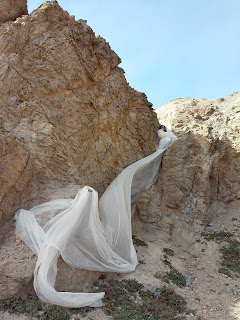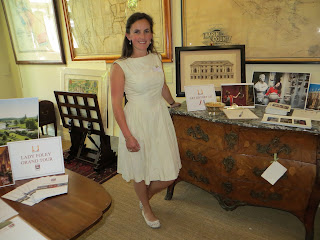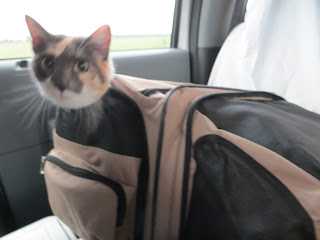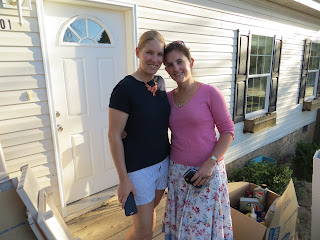The water nymph Ondine above the Pacific
Photo credit: Lauren Matley
After
bidding farewell to Maxine and Paul after the epic cross-country journey at
Charlotte airport in North Carolina, I was thrilled to see that my Frontier
plane was adorned with a handsome red fox. (I was less thrilled to discover
that Frontier charges $30 to check in a bag and $40 for a carry on! Worse than
Ryanair.) I was flying north to Pennsylvania to attend the Bryn Mawr Hound Show, at 101 years the oldest hound show in the US. It takes place in the
grounds of the elegant Radnor Hunt Club, more of a country club than the muddy
village pub British hunt followers are used to congregating in, with tennis courts, a swish cross-country course and even a steeplechase circuit. In my capacity as Horse & Hound correspondent, I was
looked after superbly by Lance Taylor and the committee, and by my hosts for
the weekend, George and Alex Hundt. Combine the twin legends of American
hospitality and hunt friendliness and you have the recipe for a perfect
weekend!
The horn-blowing competition at Radnor Hunt Club on the
sultry evening before the show
Looking out over the cross-country course, with its rather nifty
viewing tower, during the pack classes
The show
itself was excellent, with classes for beagles, bassets and four types of foxhound,
English, American, Crossbred and Penn-Marydel (named after Pennsylvania,
Maryland and Delaware, where it was first bred). At the dinner the night before,
held in the clubhouse itself, copies of the original hound show catalogue from
1915 adorned the tables. Apart from the addition of basset classes and the fact
that crossbred hounds were called half-breds, little seemed to have changed. On
the day, hunt staff in white coats and judges in bowler hats, men in linen
suits and ladies in summer dresses paraded between the rings and took shelter
from the sun under the trees. (I heard on the grapevine that a certain
Englishman, now hunting hounds in Maryland, requested the committee to plant
more trees as a matter of urgency. Unfortunately, they couldn’t be induced to
grow quickly enough to shade the foxhound rings…) I do love scenes such as
this, familiar all over England, that look as if they could be from any time in
the past hundred years. I felt very much at home, especially as, in these
Eastern states, the English rural idyll is taken as the model for life. The
houses are full of English hunting prints, Munnings and Lionel Edwards no less,
hunt whips hang in the hall and books from Memoirs
of an Irish R.M. to Going Home by
Jim Meads fill the shelves. People here are blissfully unafraid to show off
their love of hunting, and even the surrounding countryside is laid out to
facilitate the chase, with rolling green fields and hunt jumps everywhere.
Welcome clouds to temper the sun: it's a tad warmer here
than at Peterborough!
Judges John (Jake) J. Carle, II, ex-MFHA and Ciaran Murphy
intent in the crossbred ring
The adorable junior handlers, with judge George Hundt
Nowhere is
that more so than in the country of Mr Stewart’s Cheshire Foxhounds, where
Irishman Ivan Dowling hunts hounds from the beautiful old stone kennels near
Unionville. I visited with Jake Chalfin, a hero of mine ever since he rescued
me from a pig of a horse out with the Co Clare in Ireland several years ago,
and now even more of a hero since a steeplechasing accident consigned him to a
wheelchair. Unfailingly cheerful, he is as involved with hunting and racing as
ever, and drove me all round the Cheshire hunt country. W. Plunket Stewart was
a businessman from Philadelphia who hunted across Pennsylvania with the Radnor,
Brandywine and others, and spent weeks searching for the perfect hunting
country. When he found it, the valley seen from what is still known today as
Kennel Lawn, he was allowed to claim it by Charles Mather of the Brandywine and
began to develop his own pack. In 1914, kennels, stables and house were built,
and he imported hounds from England, developing a fine pack over the years and
benefitting from English hunts scaling back after the Second World War. He
continued to buy up farms, converting them to pasture and building jumpable
rails everywhere, and his work was continued by his stepdaughter, Nancy Hannum.
Thus the land hunted today is much the same as that which she hunted as master
until retiring in 2003 after 58 years. It is a tribute to her and her father’s
work that so much country remains at a time when the Philadelphia sprawl is
swallowing up the Radnor country, and I can’t wait to tackle the post-and-rail
fences that criss-cross the rolling fields next season. Ivan’s breeding work
has built up an attractive crossbred bitch pack of which, by all accounts, Mr
Stewart would be proud.
Me and Jake at Bryn Mawr
The beautiful Cheshire hunt kennels, with foxes atop the stone piers
and a mounting block fashioned by huntsman Ivan from trees
planted by Mr Stewart himself. These kennels date from 1938,
after the previous two buildings burnt down
A hunt jump leading from the kennels to the stables
The famous Brooklawn Double on Newark Road near Nancy Hannum's house.
Riders jump the rails on one side, skitter across the road and jump out again.
Everywhere, fences are set well back from the road to give room for hounds
and horses. This is truly a land dedicated to hunting!
A curious Cheshire hound
Me at Foxy Loxy, an unashamedly hunting themed café in Unionville
There was
much for the huntsmen to be proud of at the Bryn Mawr show. Although I’ve
hunted for years, I am inexperienced when it comes to studying the finer points
of hound confirmation. Fortunately, I could not have asked for a better tutor than Mason
Lampton MFH of the Midland in Georgia, who invited me to ‘co-judge’ (read,
stand next to him and listen), in the Penn-Marydel ring. We were treated to a
lovely parade of hounds, particularly Golden’s Bridge Farmer, who took breed
champion, and the black-and-tan of Andrews Bridge. His advice must have paid
off, as when Jake Carle, judging the Crossbred, asked me to put the top three
in order, I chose the same as him. A proud moment! Daphne and Marty Wood,
joint-masters of the Live Oak and judging supreme champion and bassets
respectively, were also kind and generous with their advice: many thanks to
all. Some of the mysteries of top lines and keels, well-let-down hocks and hare
feet have now been revealed! The joy of a hound show, as opposed to the
over-bred Crufts classes, is that everything has a basis in performance.
Every point of confirmation, from well-muscled haunches to straight elbows, arises from the
need to gallop and jump across rough country in pursuit of quarry.
The champion foxhound, crossbred New Market-Middletown Valley Widget 2014, was a perfect example of her breed, with beautiful lines and lovely movement. It was a pleasingly British affair: she is the granddaughter of the great sire Duke of Beaufort’s Bailey and was shown by Alasdair Storer, formerly of the Newcastle and District Beagles. He was joined in the foxhound championship by two other Brits, Sam Clifton with Green Spring Valley Fanshaw (Reserve Champion) and Stephen ‘Reg’ Spreadborough with Orange County Manic. Rule Britannia!
Mason Lampton MFH concentrating in the Penn-Marydel ring
Golden's Bridge Farmer, champion registered dog
Me and my judging guru, Mason Lampton
The fine, upstanding Bryn Mawr judges
The champion foxhound, crossbred New Market-Middletown Valley Widget 2014, was a perfect example of her breed, with beautiful lines and lovely movement. It was a pleasingly British affair: she is the granddaughter of the great sire Duke of Beaufort’s Bailey and was shown by Alasdair Storer, formerly of the Newcastle and District Beagles. He was joined in the foxhound championship by two other Brits, Sam Clifton with Green Spring Valley Fanshaw (Reserve Champion) and Stephen ‘Reg’ Spreadborough with Orange County Manic. Rule Britannia!
Champion hound New Market-Middletown Valley Widget, with whip
Michelle McKenna, show president L. Stockton Illoway, NMMV joint-master
Katherine Byron with the John H. Richards Jr Memorial Trophy,
judge Daphne Wood MFH and huntsman Alasdair Storer
Michelle McKenna, show president L. Stockton Illoway, NMMV joint-master
Katherine Byron with the John H. Richards Jr Memorial Trophy,
judge Daphne Wood MFH and huntsman Alasdair Storer
Ally and Sam Clifton, huntsman, show off Green Spring Valley Fanshaw
Huntsman Codie Jane Hayes with Golden's Bridge Farmer
in the Foxhound Championship
A fine line-up in the Foxhound Championship, NMMV Widget,
GSV Fanshaw, Orange County Manic and GB Farmer
What a beautiful bitch! NMMV Widget
Despite the
heat, this is glorious country, and I can’t wait to come back when the
temperature has dropped and hunting has begun. I have already heard tales of
the legendary Green Spring Valley hedge and in a land where the pinnacle of the
year is the Maryland Hunt Cup, 22 high post-and-rail fences taken at full
gallop, I can be sure of some exciting days. And if the welcome is anything
like that extended by Maryland Hunt Cup winner George Hundt and his wife Alex, in whose beautiful house I spent
the weekend, I am guaranteed to have a wonderful time.
Me with George and Alex Hundt
Dennis Foster, executive director of the MFHA and me.
Dennis has long been an enormous help with my articles,
answering any and all questions fully and promptly,
so it was wonderful to meet him in person at last!
Back in the
blissfully chilly fog of San Francisco, I turned my attention to another show, this time a play:
Ondine, the tale of a water nymph who falls in love with a mortal knight. First
told by Jean D’Arras in the 14th century, the story has appeared in
several forms, most familiarly as The
Little Mermaid by Hans Christian Andersen (and Disney), and was written as a
play by Jean Giraudoux in 1938. Now, it has been reimagined by We Players, a
wonderful company known for setting plays in imaginative outdoor settings – the
Odyssey on Angel Island, Macbeth at Fort Point and Hamlet on Alcatraz. I only
wish I'd heard of them before.
Ondine enchants her knight, Hans Von Wittenstein zu Wittenstein
Photo credit: Lauren Matley
I saw
Ondine first on a cool Sunday evening, tendrils of fog slipping through the
grey Monterey cypresses and the occasional spotlight of sunlight breaking
through the clouds. Together with a group of friends and members of the Golden Gate National Parks Conservancy, who have
long been supportive of We Players ventures, Julie Parish had invited me to
watch the play and have dinner afterwards. Unbeknownst to us, dinner meant a
three-course meal in a tent in Sutro Park, yards from where the play reached
its moving conclusion. Delicious canapes, fine wine and sea bass, not to
mention sparkling repartee from Will Parish, made for a fittingly enchanted end
to a night that began with amusement at Benjamin Stowe’s splendid knight Hans Von
Wittenstein zu Wittenstein, continued through laughter at Nathaniel Justiniano's hopeless
attempts to keep order over court entertainers as the Lord Chamberlain and
finished with solemnity at Ava Roy’s heartfelt discourse on love as the unaffected
and searingly honest Ondine.
Julie Parish in our outdoor dining room, complete
with sea-themed tablecloth. We deduced that the grey lines
were fog; the gold, sand; the turquoise, sunny sea; the blue, foggy sea
Julie
invited producer Lauren Chavez to join us, which gave me the opportunity to
re-enter the world of theatre. I produced several plays at St Andrews
University, principally with the brilliant director Henriette Morrison of Pip Productions (now the CEO and artistic director of Theatre of Europe), most
memorably The Tale of Pi in the East
Sands boathouse. I have many happy memories of sourcing hay bales, carrying
mattresses down Market Street on car roofs and rigging up a way of raising and
lowering painted sails from a network of beams. If there is one essential tool
a producer needs, it is duct tape. I produced a couple more plays after
university, Le Cid by Corneille at the Edinburgh Fringe and the Charles Mee
project at the Canal Café Theatre in London, but then my writing career took over. I still
feel a pang every time I go to the theatre, so I was thrilled when Lauren
accepted my offer of help.
No, I wasn't taking over the role of the king from the hilarious Nick Medina,
but who can resist sitting in a throne?
The start of the play, with the fisherman lonely in his boat
on the Sutro Baths at the foot of the cliffs
Hopefully, a successful fishing trip...
I duly
arrived at the production office at 2.30pm on Friday in vaguely 'period' dress, to be greeted by the
life-affirming smile of production manager Amy Marie Haven. Thus began a
blissful couple of days, hauling rickety carts up steep paths from the Act 1
stage by the ruined baths themselves, serving meringues to the audience after
Act 2 and taking a bow with the other production staff as we stretchered off
the dead Hans. As Ava said, the production staff do the work, so why shouldn’t
they get the curtain call? What a perceptive woman. We Players have a great
crew who never stopped smiling and are justly proud of a magnificent
production. There's no room for diva-ish antics when you're doing a play like this, when everyone is required to run up and down cliffs, adapt to a very different stage surface, block out the distraction of the general public (there's no way to close off these places altogether) and change costumes in a makeshift green room. Being deaf, I always fear that I won't hear everything when watching a play, especially outdoors, but these actors were superb: clear and loud and audible. Thank goodness some actors still learn to project their voices, unlike big-name film stars who draw the crowds to the theatre and then, used as they are to a microphone picking up every whisper, mumble their way through their lines. Here, I could follow everything, from Ondine's elegy to a trout to Bertha's anguish at being unmasked as a fisherman's daughter. Thank you, the cast of Ondine!
Act 2 changing area under part of the old Sutro mansion
An Ondine disappears - literally over a cliff. Intrepid bunch, these actors
Ondine makes an unusual entrance
One good thing about the play being outdoors and so spread out was that we didn't have to worry about giggling backstage...and there was plenty of hilarity to be had fetching white hot chocolate for Amy (the barista knew exactly who it was for as soon as we gave the order) from the café window dedicated to dog walkers (carts full of equipment count as dogs, don't they?), lugging the rowing boat up from the baths with Eliza at the oars and piling the carts as high as they could go with the judicious application of bungee cords. Whether on a Scottish coast saving the cucumber sandwiches from seagulls during The Importance of Being Earnest or a Californian coast watching whales spout just yards from the stage, theatre people always know how to have a good time!
Amy and Eliza make like pack horses for the walk up the cliffs from Act 1
Row, row, row the boat, gently up the hill
Liz, Eliza and Megan in action, although I think it might
have been Gabe at the back who was really doing the hard work!
Er, is this part of the play, Gabe?
The carts got piled a lot higher than this!
Final clear up at Ondine HQ
Production manager extraordinaire Amy Marie Haven and me
We are blessed in San Francisco to have a spectacular selection of
outdoor spaces just begging to be turned into other worlds, and no one shows
them to advantage better than We Players. As directors Ava Roy and Carly Cioffi
say in the programme: ‘The pairing of play and place is central to all We
Players productions. With Ondine at Sutro, we immerse ourselves in a passionate
and elemental play at a site where the forces of nature are profound, visceral
and omnipresent… the power and unknowable depths of the ocean mirror the
ubiquitous presence and potency of the water throughout the play.’
The edge of Sutro Baths and Seal Rock
The Ondines gather...
A nymph? A sprite? Perhaps... or production assistant Angie
Next up
this autumn is Heroes and Monsters, inspired by Beowulf, and I can’t wait to
see what site they choose. With any luck, they’ll need another stage hand behind the scenes...

























































































































































